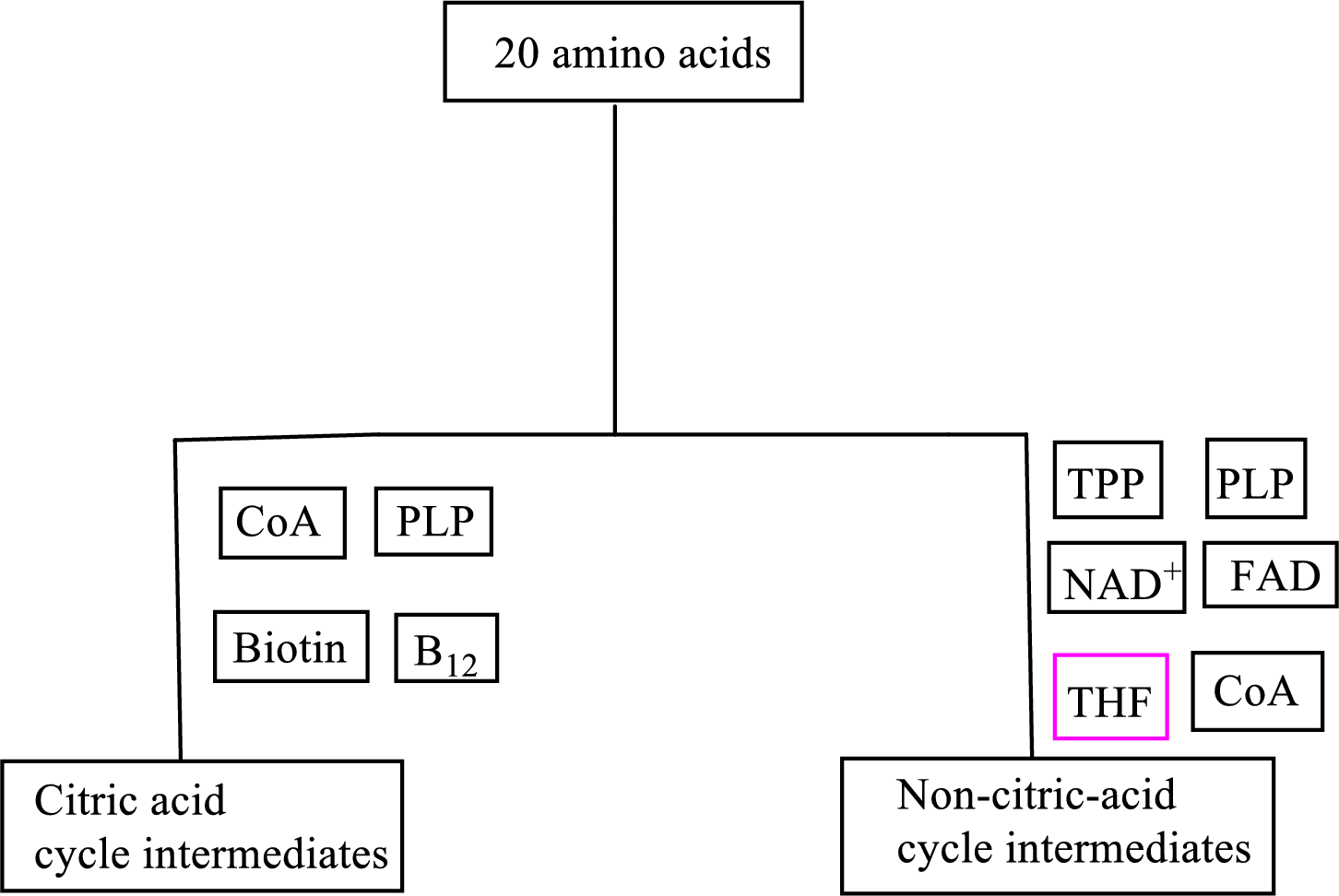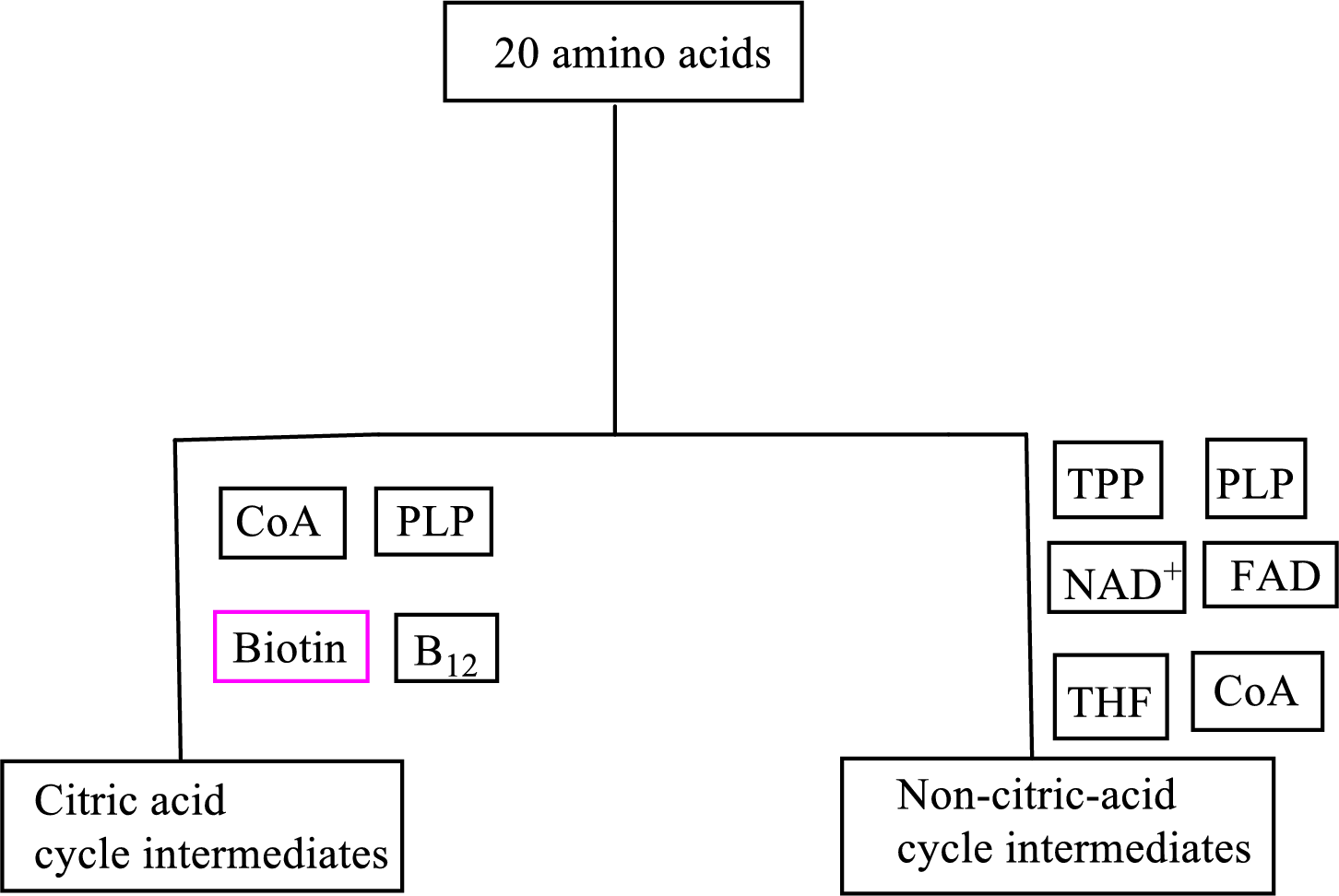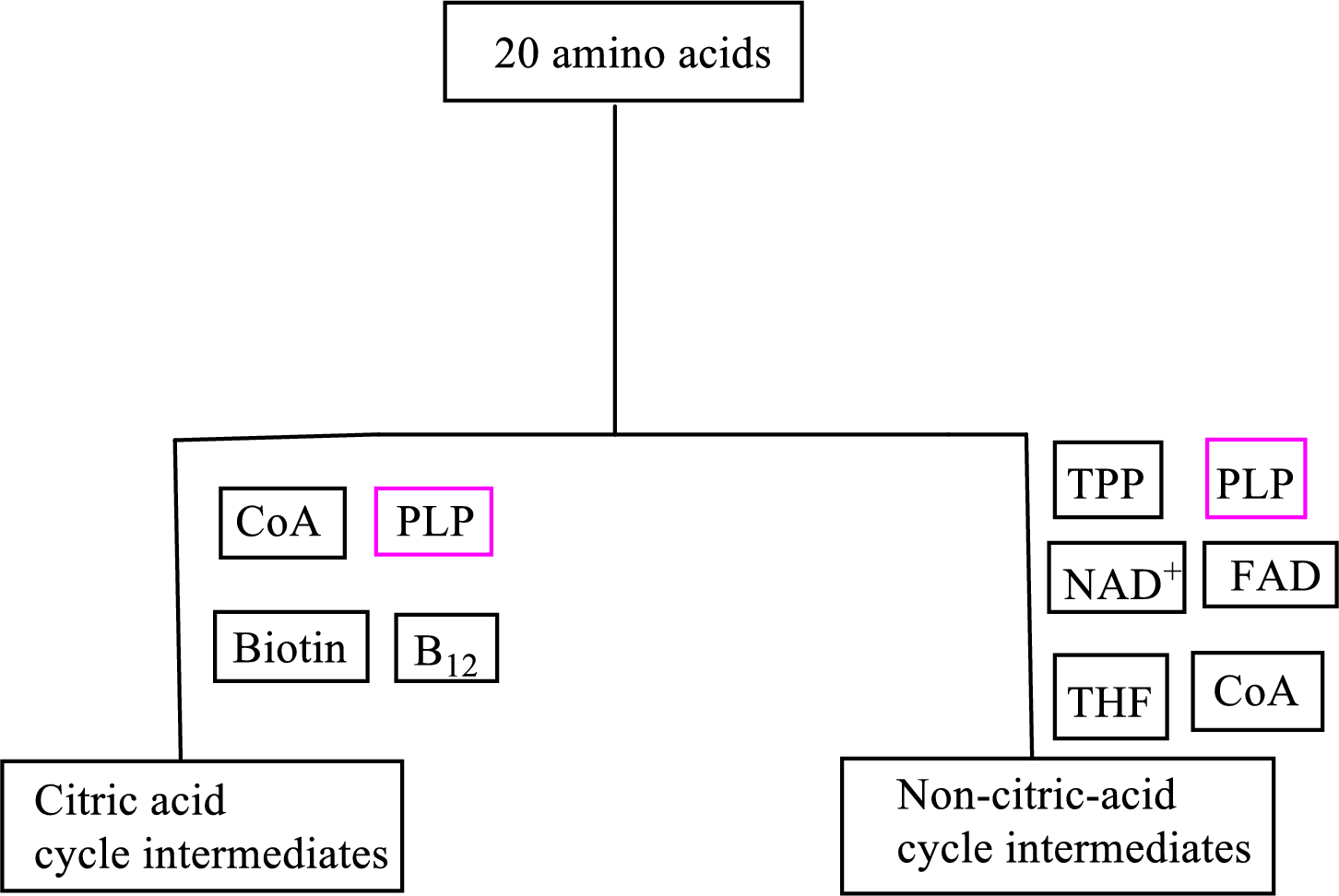
Concept explainers
(a)
Interpretation:
To indicate whether B vitamin niacin is involved as a cofactor in the processes of (1) transamination, (2) oxidative deamination, (3) urea cycle, (4) carbon skeleton degradation to CAC intermediates, or (5) carbon skeleton degradation to non-CAC intermediates.
Concept introduction:
Cofactors are non-protein organic compounds that are used along with the enzymes and help to carry forward the reaction. The coenzymes containing B-vitamin serve as temporary carriers of atoms or
Transamination reaction is a biochemical reaction that involves the transfer of an amino group. In transamination reaction exchange of an amino group from an
A biochemical reaction in which an
A urea cycle is a cyclic biochemical pathway that involves the production of urea using ammonium ions and aspartate molecules as nitrogen sources. The reactants in the formation of carbamoyl phosphate are ammonium ion, water, and carbon dioxide. The desired product of the urea cycle is urea.
There are 20 standard amino acids. Each amino acid has a different carbon skeleton and has a different degradation pathway for its carbon skeleton.
(a)
Answer to Problem 26.115EP
B vitamin niacin is involved as a cofactor in the process of oxidative deamination and in carbon skeleton degradation to non-CAC intermediates.
Explanation of Solution
Coenzyme nicotinamide adenine dinucleotide
Oxidative deamination reaction of glutamate requires dehydrogenase enzyme. It is an oxidoreductase enzyme and works with either
The oxidative deamination reaction of glutamate amino acid is as follows:

Nicotinamide adenine dinucleotide

(b)
Interpretation:
To indicate whether B vitamin folate is involved as a cofactor in the processes of (1) transamination, (2) oxidative deamination, (3) urea cycle, (4) carbon skeleton degradation to CAC intermediates, or (5) carbon skeleton degradation to non-CAC intermediates.
Concept introduction:
Cofactors are non-protein organic compounds that are used along with the enzymes and help to carry forward the reaction. The coenzymes containing B-vitamin serve as temporary carriers of atoms or functional groups in the redox and group transfer reactions associated with the metabolism of ingested food in order to obtain energy from the food.
Transamination reaction is a biochemical reaction that involves the transfer of an amino group. In transamination reaction exchange of an amino group from an
A biochemical reaction in which an
A urea cycle is a cyclic biochemical pathway that involves the production of urea using ammonium ions and aspartate molecules as nitrogen sources. The reactants in the formation of carbamoyl phosphate are ammonium ion, water, and carbon dioxide. The desired product of the urea cycle is urea.
There are 20 standard amino acids. Each amino acid has a different carbon skeleton and has a different degradation pathway for its carbon skeleton.
(b)
Answer to Problem 26.115EP
B vitamin folate is involved as a cofactor in carbon skeleton degradation to non-CAC intermediates.
Explanation of Solution
Coenzyme tetrahydrofolate

(c)
Interpretation:
To indicate whether B vitamin biotin is involved as a cofactor in the processes of (1) transamination, (2) oxidative deamination, (3) urea cycle, (4) carbon skeleton degradation to CAC intermediates, or (5) carbon skeleton degradation to non-CAC intermediates.
Concept introduction:
Cofactors are non-protein organic compounds that are used along with the enzymes and help to carry forward the reaction. The coenzymes containing B-vitamin serve as temporary carriers of atoms or functional groups in the redox and group transfer reactions associated with the metabolism of ingested food in order to obtain energy from the food.
Transamination reaction is a biochemical reaction that involves the transfer of an amino group. In transamination reaction exchange of an amino group from an
A biochemical reaction in which an
A urea cycle is a cyclic biochemical pathway that involves the production of urea using ammonium ions and aspartate molecules as nitrogen sources. The reactants in the formation of carbamoyl phosphate are ammonium ion, water, and carbon dioxide. The desired product of the urea cycle is urea.
There are 20 standard amino acids. Each amino acid has a different carbon skeleton and has a different degradation pathway for its carbon skeleton.
(c)
Answer to Problem 26.115EP
B vitamin biotin is involved as a cofactor in carbon skeleton degradation to CAC intermediates.
Explanation of Solution
Biotin is involved in the carbon skeleton degradation pathway to CAC intermediates. An overview of the B vitamin participations in the degradation pathways for the carbon skeletons of the 20 standard amino acids is as follows:

(d)
Interpretation:
To indicate whether B vitamin
Concept introduction:
Cofactors are non-protein organic compounds that are used along with the enzymes and help to carry forward the reaction. The coenzymes containing B-vitamin serve as temporary carriers of atoms or functional groups in the redox and group transfer reactions associated with the metabolism of ingested food in order to obtain energy from the food.
Transamination reaction is a biochemical reaction that involves the transfer of an amino group. In transamination reaction exchange of an amino group from an
A biochemical reaction in which an
A urea cycle is a cyclic biochemical pathway that involves the production of urea using ammonium ions and aspartate molecules as nitrogen sources. The reactants in the formation of carbamoyl phosphate are ammonium ion, water, and carbon dioxide. The desired product of the urea cycle is urea.
There are 20 standard amino acids. Each amino acid has a different carbon skeleton and has a different degradation pathway for its carbon skeleton.
(d)
Answer to Problem 26.115EP
Explanation of Solution
Coenzyme
Transamination reaction involves a simple transfer of amino groups but the overall reaction occurs in several steps and also requires
Coenzyme
An overview of the B vitamin participations in the degradation pathways for the carbon skeletons of the 20 standard amino acids is as follows:

Want to see more full solutions like this?
Chapter 26 Solutions
GENERAL,ORGANIC,+BIO.CHEM.-MINDTAP
- 6. For each of the following, fill in the synthesis arrows with reagents and show the intermediates. You DO NOT need to use the same number of arrows that are shown (you may use more or less), but the product must be formed from the reactant. Then write the mechanism of one step in the synthesis (you can choose which step to write the mechanism for), including all reagents required, clearly labeling the nucleophile and electrophile for each step, and using curved arrows to show the steps in the mechanism. a. b. OHarrow_forwardDraw the productsarrow_forwardDraw the correct productsarrow_forward
- E Organic Chemistry Maxwell Draw the correct products, in either order, for the ozonolysis reaction: 1) O3, CH2Cl2, -78 °C Product 1 + Product 2 2) Zn, HOAc Draw product 1. Select Draw Templates More C H O presented by M Draw product 2. Erase Select Draw Templates M / # # carrow_forward✓ edict the products of this organic reaction: ---- ။ A CH3–C−NH–CH2–C−CH3 + KOH ? Specifically, in the drawing area below draw the condensed structure of the product, or products, of this reaction. If there's more than one product, draw them in any arrangement you like, so long as they aren't touching. If there aren't any products because this reaction won't happen, check the No reaction box under the drawing area. Explanation Check Click anywhere to draw the first atom of your structure. C 2025 McGraw Hill LLC. All Rights Reserved. Terms of Use | Privacy Center | Accessibiliarrow_forwardPredict the product of this organic reaction: A HO-C-CH3 + CH3NH2 P+ H2O Specifically, in the drawing area below draw the condensed structure of P. If there is no reasonable possibility for P, check the No answer box under the drawing area. Explanation Check Click anywhere to draw the first atom of your structure. marrow_forward
- H 1) OsO4, pyridine 2) Na2SO3 or NaHSO3 in H₂O 2 productsarrow_forward● Biological Macromolecules Naming and drawing cyclic monosaccharides Your answer is incorrect. • Row 1: Your answer is incorrect. Row 3: Your answer is incorrect. • Row 4: Your answer is incorrect. Try again... 0/5 Give the complete common name, including anomer and stereochemistry labels, of the following molecules. You will find helpful information in the ALEKS resource. CH2OH OH OH H H I H OH OH H] H CH2OH H OH ẞ-L-sorbose HOCH2 OH OH H HOCH2 H OH OH H OH H H CH2OH OH H H OH H I- H OH H OH Explanation Recheck W E R % 25 α B Y X & 5 D F G H McGraw Hill LLC. All Rights Reserved. Terms of Use | Pr Parrow_forwardWhat is the missing reactant in this organic reaction? + R -A HO IN + H₂O Specifically, in the drawing area below draw the skeletal ("line") structure of R. If there is more than one reasonable answer, you can draw any one of them. If there is no reasonable answer, check the No answer box under the drawing area. Note for advanced students: you may assume no products other than those shown above are formed. Explanation Check Click and drag to start drawing a structure. © 2025 McGraw Hill LLC. All Rights Reserved. Terms of Use | Privacy Centerarrow_forward
- Stuc X ctclix ALE X A ALE אן A ALEX Lab (195 X Nut x M Inb x NU X NUT X Unt x + → C www-awu.aleks.com/alekscgi/x/Isl.exe/10_u-lgNslkr7j8P3jH-IQ1g8NUi-mObKa_ZLx2twjEhK7mVG6PulJI006NcKTV37JxMpZuyrVCdQolLAKqp_7U3r1GUD3... New Chrome available: Naomi Question 26 of 39 (4 points) | Question Attempt: 1 of Unlimited Give the IUPAC name. 2,3-dimethylhexane Part: 1/2 Part 2 of 2 Draw the skeletal structure of a constitutional isomer of the alkane above that contains a different number of carbons in its longest chain. Skip Part Check Click and drag to start drawing a structure. 3 Finance headline Q Search mwa Harvard Intensifi... X Save For Later 00 dlo HB Submit Assignment 2025 McGraw Hill LLC. All Rights Reserved. Terms of Use | Privacy Center | Accessibility a 9:11 PM 4/22/2025arrow_forwardPredict the product of this organic reaction: + NH2 HO A P+ H2O Specifically, in the drawing area below draw the skeletal ("line") structure of P. If there is no reasonable possibility for P, check the No answer box under the drawing area. Click and drag to start drawing a structure. ✓arrow_forward个 Stuc X ctclix ALE X A ALE × A ALE X Lab x (195 × Nut x M Inbx EF 目 → C www-awu.aleks.com/alekscgi/x/Isl.exe/10_u-IgNslkr7j8P3jH-IQ1g8NUi-mObKa_ZLx2twjEhK7mVG6PulJI006NcKTV37JxMpz Chapter 12 HW = Question 27 of 39 (5 points) | Question Attempt: 1 of Unlimited Part: 1/2 Part 2 of 2 Give the IUPAC name. Check 3 50°F Clear ©2025 McGraw Hill L Q Search webp a عالياكarrow_forward
 Chemistry for Today: General, Organic, and Bioche...ChemistryISBN:9781305960060Author:Spencer L. Seager, Michael R. Slabaugh, Maren S. HansenPublisher:Cengage Learning
Chemistry for Today: General, Organic, and Bioche...ChemistryISBN:9781305960060Author:Spencer L. Seager, Michael R. Slabaugh, Maren S. HansenPublisher:Cengage Learning General, Organic, and Biological ChemistryChemistryISBN:9781285853918Author:H. Stephen StokerPublisher:Cengage Learning
General, Organic, and Biological ChemistryChemistryISBN:9781285853918Author:H. Stephen StokerPublisher:Cengage Learning Organic And Biological ChemistryChemistryISBN:9781305081079Author:STOKER, H. Stephen (howard Stephen)Publisher:Cengage Learning,
Organic And Biological ChemistryChemistryISBN:9781305081079Author:STOKER, H. Stephen (howard Stephen)Publisher:Cengage Learning, Introduction to General, Organic and BiochemistryChemistryISBN:9781285869759Author:Frederick A. Bettelheim, William H. Brown, Mary K. Campbell, Shawn O. Farrell, Omar TorresPublisher:Cengage LearningChemistry: Matter and ChangeChemistryISBN:9780078746376Author:Dinah Zike, Laurel Dingrando, Nicholas Hainen, Cheryl WistromPublisher:Glencoe/McGraw-Hill School Pub Co
Introduction to General, Organic and BiochemistryChemistryISBN:9781285869759Author:Frederick A. Bettelheim, William H. Brown, Mary K. Campbell, Shawn O. Farrell, Omar TorresPublisher:Cengage LearningChemistry: Matter and ChangeChemistryISBN:9780078746376Author:Dinah Zike, Laurel Dingrando, Nicholas Hainen, Cheryl WistromPublisher:Glencoe/McGraw-Hill School Pub Co





